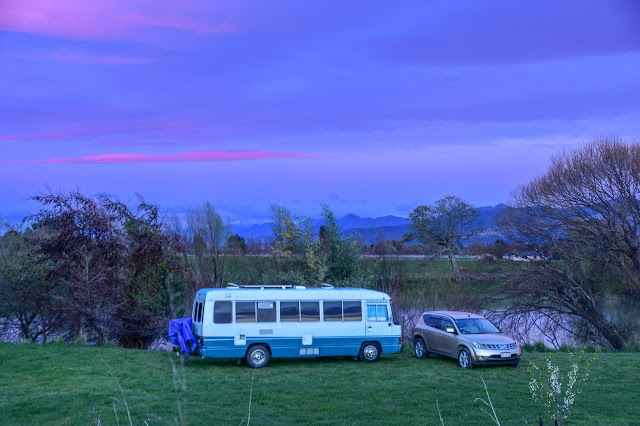Bernie has just bought me a new tripod, so this was the perfect opportunity to try it out.
At first the foreground was dark but as the sun rose higher, rows and rows of grape-vines seemed to magically appear.
It wasn't long before the sky changed again and pinky mauve tones emerged.
As was I taking my gumboots off back at the bus, I noticed the nearby tree had a golden glow as the early morning light touched it. For a second, I toyed with the idea of walking further along the river to see what the willows would look like. It was a toss up between the colours of the willows or my warm, snuggly bed. Surprisingly, the willows won!
And, crikey it was worth it. Although it's spring, the trees had the look of autumn.
And, then it was back to the bus, where I received the warmest greeting from my furry-friends. What a great start to the day!
I thought, I'd show you where we're staying and what Damfam Vineyard is like.
How To Get There
From Blenheim drive north towards Picton, turn right at the Spring Creek roundabout. Cross the one way bridge (Ferry Bridge) over the Wairau River and turn right into Wairau Bar Road.
Drive about a kilometre along Wairau Bar Road and you'll see on the right, a hand-written sign, 'Damfam Vineyard'.
Drive over the small gravel rise and follow the road ...
To your left you'll see the vineyard that supplies grapes to Yealands.
As you drive through the gate, on your right, is a recycled fridge. It's full of books campers have left for others to enjoy and beside the 'library' is the box to pay for your stay.
And, only metres away is where you can fill up with fresh water.
As you can see, I took these photos after a few days of rain. However, Winston has assured us that despite the rain the ground remains firm - he hasn't had to tow anyone out yet!
Puddle reflections ...
In the distance you can spot our bus....
And a close up photo shows us parked beside the river.
Near the bus is an intriguing tree. I'm guessing it's a fruit tree as it's smothered in blossom...but why does it have plastic bottles hanging from it? I need to find out...
And then there are the sheep. Several protective ewes were busy safeguarding their lambs, ensuring they didn't wander too far or get into any mischief. Some lambs appeared to be timid, staying close to mum, while others were more adventurous and attempted socialising. They didn't always get a friendly welcome, there were a few unfriendly sheep about! However it was great entertainment watching their shenanigans.
Damfam Vineyards is an ideal place to stay if you're about to catch the ferry to cross to the North Island or if you've just crossed over to the Mainland. Being dog friendly is a bonus and for those travelling in large vehicles, there's oodles of space.
The sunsets are pretty special too.
Thank you 'Damfam Vineyard' (Winston & Robyn), for sharing your slice of paradise.































































